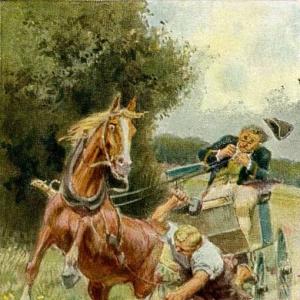Reading time: 8 min
There was once a fine gentleman who possessed among other things a boot-jack and a hair-brush; but he had also the finest shirt-collar in the world, and of this collar we are about to hear a story. The collar had become so old that he began to think about getting married; and one day he happened to find himself in the same washing-tub as a garter.
„Upon my word,“ said the shirt-collar, „I have never seen anything so slim and delicate, so neat and soft before. May I venture to ask your name?“
„I shall not tell you,“ replied the garter.
„Where do you reside when you are at home?“ asked the shirt-collar.
But the garter was naturally shy, and did not know how to answer such a question.
„I presume you are a girdle,“ said the shirt-collar, „a sort of under girdle. I see that you are useful, as well as ornamental, my little lady.“
„You must not speak to me,“ said the garter; „I do not think I have given you any encouragement to do so.“
„Oh, when any one is as beautiful as you are,“ said the shirt-collar, „is not that encouragement enough?“
„Get away; don’t come so near me,“ said the garter, „you appear to me quite like a man.“
„I am a fine gentleman certainly,“ said the shirt-collar, „I possess a boot-jack and a hair-brush.“ This was not true, for these things belonged to his master; but he was a boaster.
„Don’t come so near me,“ said the garter; „I am not accustomed to it.“
„Affectation!“ said the shirt-collar. Then they were taken out of the wash-tub, starched, and hung over a chair in the sunshine, and then laid on the ironing-board. And now came the glowing iron.
„Mistress widow,“ said the shirt-collar, „little mistress widow, I feel quite warm. I am changing, I am losing all my creases. You are burning a hole in me. Ugh! I propose to you.“
„You old rag,“ said the flat-iron, driving proudly over the collar, for she fancied herself a steam-engine, which rolls over the railway and draws carriages.
„You old rag!“ said she.
The edges of the shirt-collar were a little frayed, so the scissors were brought to cut them smooth.
„Oh!“ exclaimed the shirt-collar, „what a first-rate dancer you would make. You can stretch out your leg so well. I never saw anything so charming. I am sure no human being could do the same.“
„I should think not,“ replied the scissors.
„You ought to be a countess,“ said the shirt collar. „But all I possess consists of a fine gentleman, a boot-jack, and a comb. I wish I had an estate for your sake.“
„What! Is he going to propose to me?“ said the scissors, and she became so angry that she cut too sharply into the shirt collar, and it was obliged to be thrown by as useless.
„I shall be obliged to propose to the hair-brush,“ thought the shirt collar. So he remarked one day, „It is wonderful what beautiful hair you have, my little lady. Have you never thought of being engaged?“
„You might know I should think of it,“ answered the hair brush; „I am engaged to the boot-jack.“
„Engaged!“ cried the shirt collar, „now there is no one left to propose to;“ and then he pretended to despise all love-making.
A long time passed, and the shirt collar was taken in a bag to the paper-mill. Here was a large company of rags, the fine ones lying by themselves, separated from the coarser, as it ought to be. They had all many things to relate, especially the shirt collar, who was a terrible boaster.
„I have had an immense number of love affairs,“ said the shirt collar, „no one left me any peace. It is true I was a very fine gentleman; quite stuck up. I had a boot-jack and a brush that I never used. You should have seen me then, when I was turned down. I shall never forget my first love. She was a girdle, so charming, and fine, and soft, and she threw herself into a washing tub for my sake. There was a widow too, who was warmly in love with me, but I left her alone, and she became quite black. The next was a first-rate dancer. She gave me the wound from which I still suffer, she was so passionate. Even my own hair-brush was in love with me, and lost all her hair through neglected love. Yes, I have had great experience of this kind, but my greatest grief was for the garter, the girdle I meant to say, that jumped into the wash-tub. I have a great deal on my conscience, and it is really time I should be turned into white paper.“
And the shirt collar came to this at last. All the rags were made into white paper, and the shirt collar became the very identical piece of paper which we now see, and on which this story is printed. It happened as a punishment to him, for having boasted so shockingly of things which were not true. And this is a warning to us, to be careful how we act, for we may some day find ourselves in the rag-bag, to be turned into white paper, on which our whole history may be written, even its most secret actions. And it would not be pleasant to have to run about the world in the form of a piece of paper, telling everything we have done, like the boasting shirt collar.
 Learn languages. Double-tap on a word.Learn languages in context with Childstories.org and Deepl.com.
Learn languages. Double-tap on a word.Learn languages in context with Childstories.org and Deepl.com.Backgrounds
Interpretations
Adaptions
Summary
Linguistics
„The Shirt-Collar“ is a fairy tale written by Danish author Hans Christian Andersen. Born in Odense, Denmark, in 1805, Andersen was a prolific writer who penned numerous fairy tales, poems, novels, and plays. Although his work includes stories for both children and adults, he is best known for his fairy tales, which have been translated into more than 125 languages and are celebrated for their originality, imagination, and moral lessons.
Andersen’s fairy tales often contain elements of fantasy and explore themes such as love, kindness, morality, and the human condition. Some of his most famous stories include „The Little Mermaid,“ „The Ugly Duckling,“ „The Emperor’s New Clothes,“ and „The Snow Queen.“
„The Shirt-Collar“ is one of Andersen’s lesser-known stories, but it remains a classic example of his unique storytelling style, which combines humor, moral lessons, and enchanting narratives. Like many of his other tales, „The Shirt-Collar“ uses inanimate objects as characters to convey its message, employing a combination of fantasy and realism that invites readers to view the world from a different perspective. The story was first published in 1848 as part of a collection titled „New Fairy Tales.“
„The Shirt-Collar“ can be interpreted in several ways, with some key themes including vanity, deceit, and the consequences of one’s actions. Here are three possible interpretations of the story.
Vanity and pride: The shirt-collar, though worn and frayed, sees itself as a fine and valuable object. It boasts about its ownership of a boot-jack and a hair-brush, which in reality belong to its master. The story illustrates the negative consequences of vanity and pride, as the collar’s arrogance eventually leads to its punishment of being turned into a piece of paper, on which its false claims are exposed.
Deceit and dishonesty: The shirt-collar exaggerates its love affairs and possessions in an attempt to impress others. By lying, the collar demonstrates the danger of dishonesty, as its false stories ultimately result in a humiliating and permanent record of its actions. The tale serves as a cautionary reminder to be truthful and genuine, rather than fabricating stories to impress others.
Consequences of one’s actions: The shirt-collar’s constant boasting and dishonesty lead to its ultimate fate of becoming a piece of paper with its entire history exposed. This outcome highlights the importance of considering the consequences of one’s actions, as they may come back to haunt us in unexpected ways. It encourages self-reflection and self-awareness, urging readers to be careful with their words and actions, as they might become a permanent and embarrassing record.
„The Shirt-Collar“ by Hans Christian Andersen is a timeless fairy tale that has inspired numerous adaptations over the years. Here are a few notable adaptations of the story.
„The King’s Tailor“ by David Baldacci: This modern retelling of „The Shirt-Collar“ is part of a collection of fairy tale retellings by well-known authors. In this version, the story is set in contemporary times and follows the tale of a tailor who is tasked with creating a suit for the king. The tailor is able to use his creativity to transform a discarded shirt-collar into a beautiful tie that catches the king’s attention.
„The Dressmaker“ (2015 film): This Australian film is loosely based on „The Shirt-Collar“ and tells the story of a talented dressmaker who returns to her hometown and transforms the lives of the women she encounters. Like the mother in „The Shirt-Collar,“ the dressmaker uses her creativity to transform discarded materials into beautiful dresses that help her clients find love and happiness.
„Cinderella“ (1950 film): While not a direct adaptation of „The Shirt-Collar,“ the Disney classic „Cinderella“ shares many similarities with the story. Like the daughter in „The Shirt-Collar,“ Cinderella is a poor girl who is transformed by a beautiful dress and catches the attention of a prince. The transformation of Cinderella’s rags into a stunning ball gown is a nod to the transformative power of creativity that is central to „The Shirt-Collar.“
„The Empress’s New Clothes“ by Larry Weinberg: This adaptation of „The Shirt-Collar“ puts a twist on the original story by focusing on the idea of deception. In this version, a pair of con artists convince the empress to wear a set of invisible clothes that only the wise can see. The story highlights the idea that appearances can be deceiving and the importance of using one’s own judgment rather than blindly following the crowd.
These are just a few examples of the many adaptations and retellings of „The Shirt-Collar“ that exist. The enduring appeal of this classic fairy tale speaks to its universal themes and the way in which it continues to resonate with audiences across generations.
„The Shirt-Collar“ by Hans Christian Andersen tells the story of a boastful shirt-collar, who once belonged to a fine gentleman. The collar, growing old and considering marriage, encounters a garter in a washing tub and attempts to flirt with it. The garter, however, refuses to engage with the collar, which then proceeds to falsely brag about owning a boot-jack and a hair-brush.
After being washed, starched, and ironed, the shirt-collar continues its quest for a partner. First, it tries to charm the scissors, which leads to the collar being damaged and discarded as useless. Then, the shirt-collar proposes to the hair-brush, who reveals that she is already engaged to the boot-jack. Feeling rejected, the collar pretends to be indifferent about love.
Eventually, the shirt-collar finds itself in a paper mill, among other rags. It boasts about its past love affairs, claiming to have been involved with numerous items, including the garter, a widow, a dancer, and the hair-brush. In the end, the collar is turned into a piece of white paper, on which this story is written, as a punishment for its exaggerations and deceit.
The moral of the story serves as a cautionary tale, warning against arrogance and dishonesty, as one’s actions may be exposed and transformed into an embarrassing and permanent record.
The fairy tale „The Shirt-Collar“ by Hans Christian Andersen presents a unique opportunity for linguistic analysis, especially in how language constructs character and moral lessons.
Here’s a closer look:
Personification and Anthropomorphism
The tale is rife with personification, where inanimate objects like a shirt-collar, garter, flat-iron, scissors, hairbrush, and boot-jack are given human traits and engage in social interactions. This anthropomorphic approach is typical in fairy tales, serving to explore human behaviors and societal norms through allegory and metaphor.
Dialogue and Characterization
Shirt-Collar: The dialogue reveals the shirt-collar as boastful and vain. He speaks in a manner that exaggerates his own importance, such as claiming ownership of the boot-jack and hairbrush, which actually belong to his master. His conversation with other objects showcases his conceited and presumptuous nature. Notably, he uses flattery as a tactic to win over potential partners.
Garter: The garter’s few responses are characterized by rejections and a sense of maintaining boundaries, indicative of modesty or shyness. This reflects societal views on gender interactions at the time, where a female character might be expected to be reserved.
Flat-Iron and Scissors: These characters respond to the shirt-collar with derision and anger, highlighting his unattractive qualities. Their dialogues embody a sense of independence and assertiveness, counteracting the collar’s advances.
Hair-Brush: Her engagement to the boot-jack further humbles the collar and undermines his pursuits, illustrating rejection grounded in established loyalty.
Language and Tone
The tone of the tale is humorous yet cautionary. Andersen employs a playful yet satirical narrative style. Words like „boaster,“ „old rag,“ and the repeated dismissals serve as a comedic critique of vanity. The shirt-collar’s exaggerated language is contrasted against the curt and straightforward replies of other objects, accentuating the discrepancy between self-perception and reality.
Themes and Morals
Vanity and Boasting: The central theme is the futility and potential downfall stemming from vanity and false pride. The shirt-collar’s narrative, laden with untruths and self-aggrandizement, ultimately leads to his demise and transformation into paper, symbolizing both a literal and metaphorical wipe of identity.
The Consequences of Deception: The story warns against deception and self-deception, emphasizing authenticity over superficiality. The collar’s fabricated tales of romance and grandeur are humorous but are eventually exposed as hollow, resulting in his downfall and reinvention as paper.
Social Commentary: Through anthropomorphism, Andersen subtly critiques the social practices of courtship and the consequences of egotism. The shirt-collar’s interactions parody societal norms, inviting readers to reflect on similar behaviors in human society.
Structural Analysis
The story unfolds linearly, yet it is framed within a cyclical structure: the shirt-collar begins as a fine object, falls from grace, and is reincarnated to narrate the very story we read. This cyclical structure emphasizes the inevitability of moral reckoning and serves as a narrative device to reinforce the moral lesson throughout the tale.
Overall, „The Shirt-Collar“ uses linguistic creativity to deliver a moral lesson using humor and irony. Andersen not only entertains but also instructs, creating a narrative that reflects on human folly through the guise of commonplace objects.
Information for scientific analysis
Fairy tale statistics | Value |
|---|---|
| Translations | DE, DE, EN, DA, ES, FR, IT, NL |
| Readability Index by Björnsson | 25.5 |
| Flesch-Reading-Ease Index | 83.9 |
| Flesch–Kincaid Grade-Level | 5.1 |
| Gunning Fog Index | 7.2 |
| Coleman–Liau Index | 7.3 |
| SMOG Index | 7.5 |
| Automated Readability Index | 4.2 |
| Character Count | 5.039 |
| Letter Count | 3.774 |
| Sentence Count | 67 |
| Word Count | 962 |
| Average Words per Sentence | 14,36 |
| Words with more than 6 letters | 107 |
| Percentage of long words | 11.1% |
| Number of Syllables | 1.232 |
| Average Syllables per Word | 1,28 |
| Words with three Syllables | 36 |
| Percentage Words with three Syllables | 3.7% |

 Facebook
Facebook  Whatsapp
Whatsapp  Messenger
Messenger  Telegram
Telegram Reddit
Reddit













